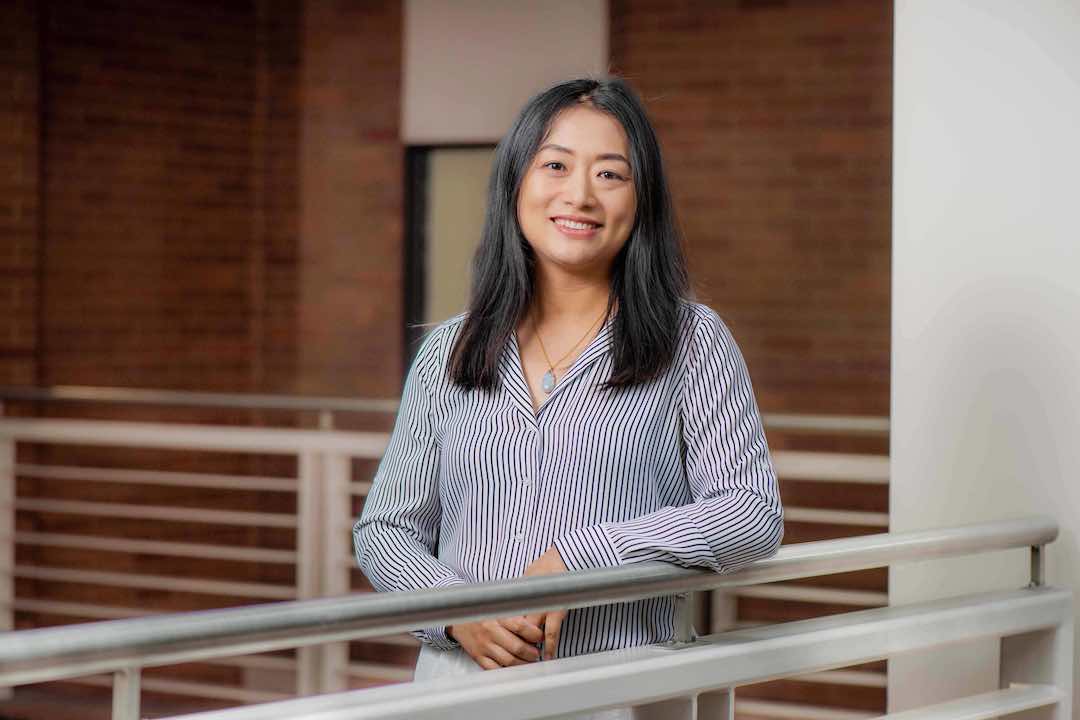Faculty member develops new sensor and signaling technology by exploring harbor seal whiskers
Bio-inspired engineering design can improve underwater vehicle stealth sensing technologies
Nate Tangeman/RIT
Qian Xue, an associate professor of mechanical engineering in RIT’s Kate Gleason College of Engineering, is a recent NSF CAREER Awardee.
Improving stealth sensing technology might start with harbor seal whiskers.
Qian Xue, associate professor of mechanical engineering at Rochester Institute of Technology, is exploring how the varied sizes, shapes, and directions of whiskers on harbor seals can correlate to better sensor technologies.
“Harbor seals are considered very intelligent, and they have extraordinary flow sensing capabilities,” said Xue, who received a CAREER Award for “Hydrodynamic sensing mechanism of seal whiskers” from the National Science Foundation.
The prestigious CAREER Award program recognizes and supports junior faculty who exemplify the role of teacher-scholars through integrated research and educational activities. RIT has more than a dozen NSF CAREER award winners working at the university.
Improvements to sensor technology based on bio-inspired designs have become a growing research area. Previous experiments have shown that harbor seals, blind-folded and monitored, have been able to follow a distinct path of a food source solely on the mechanical signals detected in the water and recognized by their whisker array.
“It’s amazing, right? This capability is what we are looking to reproduce in this natural design. How do they achieve this capability? They only sense the flow movement, and they can differentiate surrounding objects of varied shapes—and they are correct. More refinement to sensor systems enables different and better functions,” she said. She joined the faculty of RIT’s Kate Gleason College of Engineering one year ago.
Seal whiskers have unique shapes, different lengths and widths, and varied orientation along the animal’s entire nose.
“They distinguish prey by the type of movement and can navigate toward it. Even in low noise ranges, there is still significant detection. A single whisker will not provide much information. You have to rely on the entire architecture,” said Xue, whose work involves developing a similarly engineered system and modeling the changing variables due to flow movements to determine sensing capabilities.
She will focus on understanding the basic mechanical functions of the arrays. Secondly, she’ll incorporate math modeling and artificial intelligence to “teach” her prototype system how vibrations, triggered by fluid dynamics and movement, are captured, interpreted, and identified.
“How can the system make connections between the signals and the object? Does this allow for capturing more on the frequency range. We believe orientation in different directions and the varied lengths of the whiskers play a big role,” she said.
This type of smart analysis could add additional capabilities to some of today’s already strong, sophisticated sensors. They detect environmental changes and there are varied types and sensitivities of sensors for different applications. For example, sonar is “sound navigation ranging” to detect and determine distance and direction of objects; radar uses radio waves to determine distance, angle, and velocity of an object.
Xue is looking to add flow movement into sensor technology because of its stealth quality as well as its ability to improve accuracy of identifying an object.
“You cannot detect an object if it does not emit light or sound, and for some applications this could be very important. This can become a very advanced sensor system, one used for different underwater vehicles where it is important to know the environment and to be sure it is tracking the correct object,” she said.
The CAREER award is the foundation for what Xue sees as a larger-scale project. This year, she will be building a flow tank model in her lab to analyze water movement across a replica of seal whiskers. An additional focus will be the development of a bio-inspired engineering education plan to impact undergraduate and graduate students, as well as an opportunity to explore these designs with a K-12 audience interested in engineering careers.




